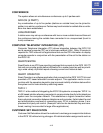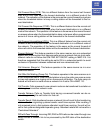TRUNK MONITOR or SERVICE OBSERVING
This feature allows the user who barged-in to retain the trunk call after the original
station has hung up.
WARNING: BARGE-IN WITHOUT TONE MAY VIOLATE STATE OR FEDERAL LAWS
CONCERNING THE RIGHT TO PRIVACY. SAMSUNG TELECOMMUNICATIONS
AMERICA IS IN NO WAY RESPONSIBLE FOR THE POSSIBLE MISUSE OF THIS
FEATURE.
EXTERNAL MUSIC INTERFACES
The system provides an interface for connecting a customer-provided external
music source and the addition of an SMISC card provides a second interface. These
interfaces can be used for background music, station music on hold or trunk music
on hold.
EXTERNAL PAGE INTERFACES
The system KSU provides one external page audio output. The addition of an SMISC
card will provide a second audio output and three general purpose relays that
may be assigned to control paging zones. Multiple relays may be assigned to a
page zone.
FLASH KEY OPERATION
While a user is on an outside line, pressing the FLASH key will flash the central
office or PBX. This is used for custom calling features on C.O. lines or in conjunction
with CENTREX/PBX operation. System programming allows individual flash times
for C.O. and PBX lines. When C.O. or PBX flash is not required, setting the timers for
two seconds releases the existing call and returns dial tone to make a new call.
FLEXIBLE NUMBERING
System programming allows stations to have two, three or four digit extension num-
bers beginning with the digit 2 or 3. Default extension numbers begin with 201.
Station group numbers can be three or four digits beginning with the digit 5.
Using digits other than 2, 3 or 5 will require the technician to change other feature
access codes in the system default numbering plan. User guides will need to be
modified as these are all written using the iDCS 100 default numbering plan.
GROUND START TRUNKS (T1)
The iDCS 100 can utilize these trunks to support a positive disconnect signal and
prevent call collisions on heavy traffic usage. Caller ID or ANI service is not avail-
able on these trunks.
GROUP BUSY SETTING
This feature provides a busy signal to intercom callers that ring to a station group
when all logged-in stations are busy. The feature can be activated on a per station
4.16
HOME
PAGE
Table of
Contents


















